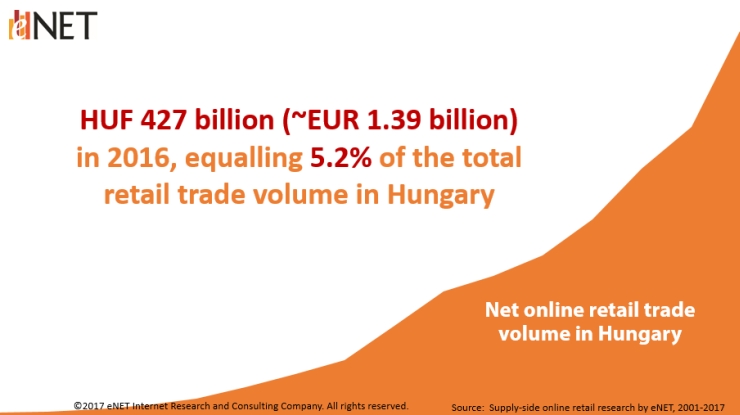Ecommerce in Hungary was worth €1.4 billion in 2016

Ecommerce in Hungary was worth 427 billion Hungarian forints, or 1.38 billion euros in 2016. The online retail industry in this Eastern European country now accounts for over 5 percent of total domestic retail sales. In Hungary, more people are shopping online while the average basket value also increases.
These are the key results from new research conducted by eNET Internet Research, which based its data on responses by local online stores and presented the results during Ecommerce Hungary Conference earlier this month.

Ecommerce industry in Hungary increased by 34 percent
In 2015, ecommerce in Hungary was worth 319 billion Hungarian forints, which corresponds to 1.03 billion euros. So, last year the online retail industry increased by almost 34 percent. But it’s not only the size of the market that has increased, also the average cart value grew. Last year, online shoppers spent about 42 euros for an average online purchase, which is 5.5 euros more than they did in 2015.
4.6 million online shoppers in Hungary
From just above 4 million in 2015, the number of online shoppers in Hungary have increased by 600,000 last year, so there are now over 4.6 million online shoppers . This means 84 percent of adult Internet users in the country now buy goods online at least once a year. And there are now 2.2 million online shoppers who order goods from foreign online stores, that’s 700,000 more than there were in 2015.
These online shoppers in Hungary like to order products from categories such as IT & entertainment electronics, clothes, toys & gifts and white goods. eNET’s research also shows that delivery by courier services is still the most popular delivery method in Hungary. Other popular options are picking up orders at the store and the seller’s site or office.
Popular payment methods in Hungary
Online stores in Hungary primarily offer cash payment upon delivery, bank transfer or cash payment in a physical store, site or office. In terms of the number and the value of orders, paying with cash when the orders are delivered is still the most popular payment option. Paying with bank cards upon delivery is gaining in popularity, though. Logistics suppliers are upgrading and expanding their services, so more couriers now have a POS terminal.

Comments